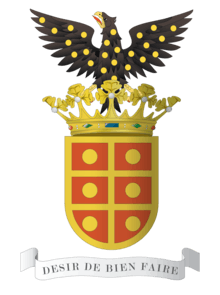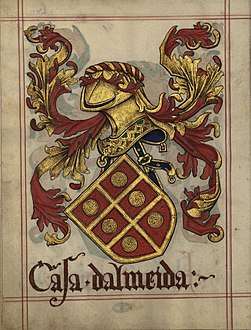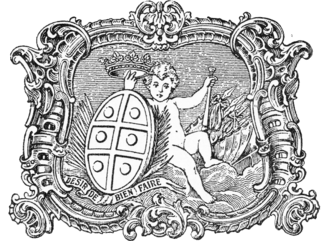Marquess of Lavradio
Marquess of Lavradio is a Portuguese title of nobility created by Letters Patent of King José I of Portugal on 18 October 1753 for D. António de Almeida Soares de Portugal, 1st Count of Lavradio and 4th Count of Avintes.
| Marquessate of Lavradio | |
|---|---|
 Coat of Arms of the Marquesses of Lavradio | |
| Creation date | 18 October 1753 |
| Monarch | José I of Portugal |
| Peerage | Peerage of Portugal |
| First holder | D. António de Almeida Soares de Portugal |
| Present holder | D. Jaime de Almeida |
| Heir apparent | D. Luís Maria de Almeida, 13th Count of Avintes |
| Subsidiary titles | Count of Avintes Count of Lavradio Count of Torres Vedras |
Titles and Honours
The first Marquess of Lavradio was a prominent statesman and the head of an established noble family. In his own right, he was the 4th Count of Avintes, and 8th Lord of Avintes, also Portuguese titles of nobility. In gratitude for the exceptional services to his country of his uncle D. Tomás de Almeida, 1st Cardinal Patriarch of Lisbon, on 12 January 1714[1] King John V of Portugal conferred on him the Seigniory of Lavradio, and the title of Count of Lavradio, in perpetuity,[lower-alpha 1] confirmed by Letters Patent of 4 June 1725, as well as adding to his commanderies in the Order of Christ.[2][3] The first Marquess held key administrative positions under kings João V of Portugal and José I of Portugal, notably as 38th Governor General of Angola, from 1748 to 1753, in recognition of which he was elevated to the marquessate, and, albeit briefly, as 8th Viceroy of Brazil in 1760.[4] He married D. Francisca das Chagas Mascarenhas,[3][lower-alpha 2] daughter of D. Martinho Mascarenhas, 3rd Marquess of Gouvêa and 6th Count of Santa Cruz, and his wife. D. Maria Rosa de Távora.[5] She died six years later in childbirth, having borne five children.
Their eldest son, the 2nd Marquess and 11th Viceroy of Brasil like his father, was arguably one of the most remarkable and respected colonial administrators in Brasil.[6] Having followed a successful army career, becoming colonel of the Cascais Regiment and rising to the rank of Brigadier during the war of 1762, he was given the governorship of the province of Bahia and was soon after promoted to Governor-General of Rio de Janeiro and Viceroy of Brasil.[7] He had 12 children by his wife, D. Maria Ana da Cunha, daughter of the 5th Counts of São Vicente.
The 3rd Marquess of Lavradio, as well as inheriting the assets that were not confiscated by the Crown from his great-uncle, the 8th Duke of Aveiro, was granted the hereditary distinction of Honras de Parente d'El Rei[lower-alpha 3] by Letters Patent of 1 June 1810, upon his becoming head of the two extant Lancastre lineages: one a legitimate bloodline of the Royal House of Aviz,[8] who were Comemdadores-mores[lower-alpha 4] of the Order of Christ; the other of the Dukes of Aveiro,[3][9] descended from the illegitimate and only surviving son of King João II, D. Jorge, Duke of Coimbra.
In addition to holding the titles of Count of Avintes, Count of Lavradio and Count of Torres Vedras, the Marquesses of Lavradio are Chiefs of the Name and Arms of the Lancastre,[10] Mascarenhas and Alarcão lineages in Portugal, and head of the noble houses of Aveiro,[10] Gouvêa, Portalegre, Santa Cruz, Montalvão and Turcifal,[11] and thus claimants to the titles of Duque of Aveiro,[10] Duque and Marquess of Torres Novas,[10] Marquess of Gouvêa, Marquess of Montalvão, Count of Portalegre, Count of Santa Cruz, Count of Castelo Novo and Count of Serém.[8][12] They also represent the curious title of Marquess of Turcifal, a Portuguese title of nobility given to the 3rd Count of Torres Vedras by Felipe IV of Spain in 1652, during the Portuguese War of Independence.[13] The title was not recognised in Portugal as Felipe was no longer de facto King of Portugal, neither was it recognised in Spain as the title was given by Felipe as titular King of Portugal.
The lengthy surname used by the Marquesses of Lavradio underlines their position as Chiefs of various lineages, as well as their legal obligation as administrators of various morgadios[lower-alpha 5], many of which inherited by marriage and subject to the use of the founder's surname.
The title of Count of Avintes, which was granted to the 4th Count and his descendants in perpetuity,[3][5] is assumed at birth by the eldest son and heir of the Marquess of Lavradio. The title of Count of Lavradio has been used on four more occasions by younger sons and close relatives of the head of the family with the latter's permission.[3][14][15]
Origins and Family History

The Marquesses of Lavradio are chiefs of one of the branches of the Almeida family of Portugal, whose noble origins and genealogy are described in detail in all Portuguese nobiliaries, notably "História Genealógica da Casa Real Portuguesa"[16] and "Memórias Históricas e Genealógicas dos Grandes de Portugal",[17] both by D. António Caetano de Sousa, and "Brasões da Sala de Sintra", by Anselmo Braamcamp Freire.[18]
Almeida family origins
Given the family's antiquity, its elevated status and influence on Portugal's history, and the scarcity of reliable documentary proof until the late 14th century, genealogists have traced a number of possible ascendencies for the Almeidas.[19] In his Chronica de Cister, Friar Bernardo de Brito, later copied by many respected genealogists, traces the Almeidas to Pelayo Amado, a 12th-century nobleman, whose grandson, Payo Guterres, took the castle of Almeida from the Moors, gaining the nickname "O Almeidão".[19] Braamcamp Freire, however, suggests Fernão Canelas,[19] owner of the estates of Pinheiro and Canelas near Mangualde in the latter part of the 12th century, as a more probable instigator of this lineage. His son, João Fernandes, founded the village of Almeida, from where he took his surname.[19] Manuel Abranches Soveral picks up on the similarities described by Braamcamp Freire[19] of the Almeida coat of arms to that of the Mello family, whose ascendency is well documented, and suggests a likely alliance by marriage early in the 13th century.[20]
The Counts of Abrantes
By the end of the 14th century, the Almeida clan had established itself amongst the highest levels of Portuguese nobility largely as a result of their proximity to King John I,[21] a relationship with the royal family that would endure for centuries.[22] Fernão Álvares de Almeida, a knight of the Order of Aviz and its Claveiro,[lower-alpha 6] who held two important commanderies in the order, sat on the Royal Council of King João I and was his Vedor da Fazenda[lower-alpha 7] and tutor to his children, the Infantes.[21][23] In 1400 he was named Governor of Abrantes.[23] His son, Diogo Fernandes de Almeida, was King Duarte's Vedor da Fazenda and as Reposteiro-mor,[lower-alpha 8] one of the most senior Court officials. He became Governor of Abrantes, following the death of his father, and was granted the Seigniory of Sardoal.[23] He married D. Brites Anes, granddaughter of Prince João of Portugal, Duke of Valencia de Campos.[23] Their son, D. Lopo de Almeida, fourth cousin to King Afonso V, was created Count of Abrantes by Royal Decree of 13 June 1476.[2]
The 1st Count of Abrantes married D. Brites da Silva, lady-in-waiting to Queen Leonor. They had an illustrious progeny,[23] which included:
- D. João de Almeida (d.1512), 2nd Count of Abrantes, adviser to King João II and his Guarda-mor;[lower-alpha 9]
- D. Diogo Fernandes de Almeida, Governor of Torres Novas, Monteiro-mor[lower-alpha 10] and 6th Prior of Crato;
- D. Jorge de Almeida, Bishop of Coimbra and 2nd Count of Arganil;
- D. Pedro da Silva, who took his mother's surname, Comendador-mor of the Order of Aviz and one of King João II's ambassadors to Rome;
- D. Fernando de Almeida, Bishop of Ceuta and Pope Alexander VI's Apostolic Nuncio to France;
- D. Francisco de Almeida, 1st Viceroy of India.
Marquesses of Lavradio (1753)
- D. António de Almeida Soares de Portugal (1701—1760), 1st Marquess and 1st Count of Lavradio, 4th Count of Avintes, 8th Viceroy of Brasil. Succeeded by his son
- D. Luís de Almeida Portugal Soares de Alarcão d'Eça e Mello Silva Mascarenhas (1729—1790), 2nd Marquess of Lavradio, 5th Count of Avintes, 11th Viceroy of Brasil. Succeeded by his son
- D. António Máximo de Almeida Portugal Soares de Alarcão Mello de Castro Ataíde d'Eça Mascarenhas Silva e Lancastre (1756—1833), 3rd Marquess of Lavradio, 6th Count of Avintes. Succeeded by his son
- D. Luís de Almeida Portugal Soares de Alarcão Mello de Castro Ataíde d'Eça Mascarenhas Silva e Lancastre (1787—1812), 4th Marquess of Lavradio, 7th Count of Avintes. Succeeded by his brother
- D. António de Almeida Portugal Soares de Alarcão Mello de Castro Ataíde d'Eça Mascarenhas Silva e Lancastre (1794—1874), 5th Marquess of Lavradio, 8th Count of Avintes. Succeeded by his great-grandson
- D. José Maria do Espírito Santo de Almeida Corrêa de Sá (1874—1945), 6th Marquess of Lavradio, 9th Count of Avintes. Succeeded by his son
- D. José Luís de Almeida (1912—1966), 7th Marquess of Lavradio, 11th Count of Avintes, following the premature death of his elder brother António, 10th Count of Avintes, in 1938. Succeeded by his son
- D. Jaime de Almeida, 8th Marquess of Lavradio, 12th Count of Avintes, 4th Count of Torres Vedras.
Coat of Arms

The Marquesses of Lavradio use the undifferenced arms of Almeida.[3]
- Shield: gules, a doubled cross or between six bezants within a bordure of the second.[2]
- Coronet: the shield is surmounted by a ducal coronet, an allusion to the titles of Duke of Aveiro and of Torres Novas.
- Crest: an eagle displayed, sable, bezanté, armed and beaked or and langued gules.[25]
- Motto: Desir de Bien Faire.
The Counts of Avintes use the same arms but for the crest with an eagle gules rather than sable.[2][26]
See also
Footnotes
- In the original Portuguese: de juro e herdade meaning "in perpetuity and by inheritance", whereby to be inherited a title required no further concession from the Crown or the State, but merely its acknowledgement.
- She was the sister of the 4th and 5th Marquesses of Gouvêa, the latter also 8th Duke of Aveiro, whose children left no legitimate descent. As a result, her grandson, António, 3rd Marquess of Lavradio also became head of the Houses of Aveiro, Gouvêa and Santa Cruz upon his cousin's death.
- The title of Honras de Parente, meaning "Kinsman to the King", is an acknowledgement of the blood relationship between the title holder and the Crown. Until the end of the monarchy in 1910 it had been granted to only 12 families in Portugal.
- Comendador-mor translates as Knight-Commander-in-Chief. It was the title given to the most senior knight in the order, second only to the Master of the Order.
- The morgadio was similar to the common law entail or fee tail in England, or the majorat in France.
- The master of the keys of the order, with responsibility for its treasury. It was a senior role in the order which encompassed the administration of its finances.
- The Vedor da Fazenda was responsible for administrating the country's economy and finances, similar to the position of Chancellor of the Exchequer.
- One of four key officials of the King's private chamber, a position reserved for the nobility.
- Captain-General of the King's Guard.
- Master of the King's Horse.
References
- http://www.arqnet.pt/dicionario/lavradio1m.html
- Caetano de Sousa, António (1755). Memórias Históricas e Genealógicas dos Grandes de Portugal. pp. 340–341.
- Braamcamp Freire, Anselmo (1996). Brasões da Sala de Sintra. Volume II. Lisbon: Imprensa Nacional-Casa da Moeda. pp. 363–364.
- da Conceição, Adriana A. (2011). "Sentir, Escrever e Governar - A prática epistolar e as cartas de D. Luís de Almeida, 2º marquês do Lavradio (1768-1779)". São Paulo: University of São Paulo: p.333.
- Mello Corrêa, Manuel; Mattos e Silva, António (1985). Anuário da Nobreza de Portugal III. Volume 1. Lisbon: Instituto Português de Heráldica. p. 100.
- Alden, Dauril (1968). Royal Government in Colonial Brazil. Berkeley: University of California Press.
- Alden, Dauril (1968). Royal Government in Colonial Brazil. Berkeley: University of California Press.
- Lavradio, Luis (2017). Lancaster 1386-2016, das Margens do Lune à Ponte do Mouro. Lightning Source UK Ltd. pp. 33–36. ISBN 9781366130969.
- Lavradio, Luis (2017). Lancaster 1386-2016, das Margens do Lune à Ponte do Mouro. Lightening Source UK Ltd. pp. 21–28. ISBN 9781366130969.
- de Lancastre e Távora, Luis Gonzaga (1973). Quem te manda a ti, sapateiro... Lisbon: CEIH. pp. 54–55.
- Lavradio, José Maria do Espírito Santo de Almeida Correia de Sá, marquês de (1993). Memórias do sexto Marquês de Lavradio. Almeida, José Luiz de, 1912?- (2nd ed.). Lisbon: Edições Atica. p. 11. ISBN 972617015X. OCLC 37761724.
- Torres., Fevereiro, José Luíz de Sampayo (2004). Uma família da Beira Baixa : os Torres Fevereiro e as suas ligações familiares (2a. ed. actualizada ed.). Lisboa: Dislivro Histórica. p. 238. ISBN 972887605X. OCLC 70293907.
- Grande Enciclopédia Portuguesa e Brasileira. Volume 32. Editorial Enciclopédia. pp. 282–283, 295.
- Mello Corrêa, Manuel; Mattos e Silva, António (1985). Anuário da Nobreza de Portugal III. Volume 1. Lisbon: Instituto Português de Heráldica. p. 400.
- Torres., Fevereiro, José Luíz de Sampayo (2004). Uma família da Beira Baixa : os Torres Fevereiro e as suas ligações familiares (2a. ed. actualizada ed.). Lisboa: Dislivro Histórica. p. 243. ISBN 972887605X. OCLC 70293907.
- Caetano de Sousa, António (1735–1749). História Genealógica da Casa Real Portuguesa. Tomo X. Lisbon: Officina de Joseph Antonio da Sylva. pp. 833–855.
- Caetano de Sousa, António (1755). Memórias Históricas e Genealógicas dos Grandes de Portugal. pp. 137–138 and 323–344.
- Braamcamp Freire, Anselmo (1996). Brasões da Sala de Sintra. Volume II. Lisbon: Imprensa Nacional-Casa da Moeda. pp. 282–427.
- Braamcamp Freire, Anselmo (1996). Brasões da Sala de Sintra. Volume II. Lisbon: Imprensa Nacional-Casa da Moeda. pp. 301–307.
- "Manuel Abranches de Soveral - Almeida". www.soveral.info. Retrieved 24 September 2017.
- Costa., Gomes, Rita (2003). The making of a court society : kings and nobles in late medieval Portugal. Cambridge: Cambridge University Press. pp. 126–127. ISBN 9780521800112. OCLC 49796307.
- Lavradio, Luis (2017). Lancaster 1386-2016, das Margens do Lune à Ponte do Mouro. Lightening Source UK Ltd. pp. 23–25. ISBN 9781366130969.
- Braamcamp Freire, Anselmo (1996). Brasões da Sala de Sintra. Volume II. Lisbon: Imprensa Nacional-Casa da Moeda. pp. 347–357.
- Avelar Duarte, Sérgio (1990). Ex-Libris Portugueses Heráldicos. Porto: Civilização. p. 294.
- Godinho, António (c. 1530). Livro da Nobreza e Perfeiçam das Armas. Lisbon. pp. fl.11.
- Brandão, António (1632). Monarchia Lusitana - Terceira Parte. Lisbon. p. 208.